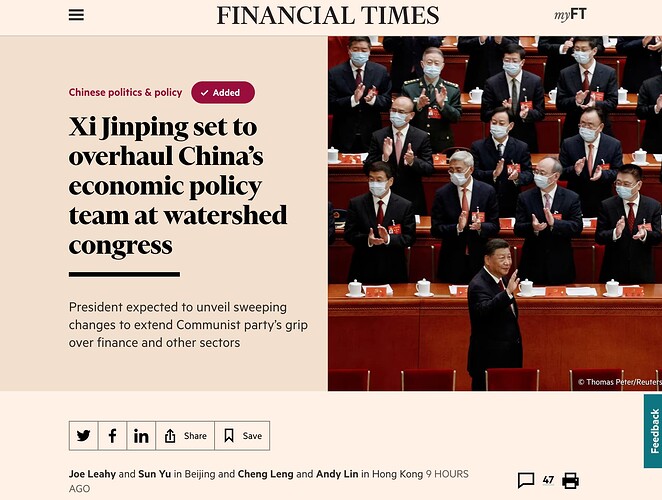-
习近平准备利用即将召开的议会橡皮图章会议,对政府进行 "强有力的 "改革。
-
这将包括替换李克强总理,重组金融部门等重要部门,并对技术和科学部门进行更严格的控制。
-
习近平还承诺增加党对 "非公有制企业 "的参与。
-
这些变化发生在中国经济的敏感时刻,中国的经济已经受到习近平的新冠清零战略和监管打击的影响。
-
2022年的国内生产总值仅增长3%,远低于5.5%的官方目标。
-
这些变化标志着权力向习近平最信任的信徒转移,党对经济的控制进一步加强。
-
这可能对商业情绪和中国经济的未来产生重大影响。
-
预计中国今年将出现反弹,上个月制造业活动以十年来最快的月度速度增长。
-
新的领导团队将必须向投资者证明,中国对商业开放,并准备解决结构性障碍,如政府债务上升、人口下降和生产力滞后。
-
大会的首要任务是为短期内的增长制定路线,并为投资者提供一条长期可持续增长的道路。
-
加州大学圣地亚哥分校中国政治经济学教授Victor Shih表示,这将是新领导团队的一个关键重点。
-
新的领导团队必须证明,中国对商业开放,并准备解决结构性问题。
-
该团队将专注于提供短期增长和长期可持续增长,以说服国内和外国投资者。
-
10月,中国国家主席习近平对七名政治局常委进行了一次大清洗,将中国共产党的最高决策机构堆满了忠诚的人。随后,他被确认为党委书记和军事首长,任期为第三个五年,全国人民代表大会修改了宪法,取消了两届任期限制。本月,他预计将被重新任命为总统。
-
预计习近平将在政府高层反映中共领导层的改组情况,政府将拥有一个由习近平过去的大量新面孔组成的团队。他可能会将前上海市委书记李强提升为总理和中国国务院或内阁的负责人。
-
这支新的效忠者团队将在未来五年为习近平服务,因为他将继续巩固权力,进一步加强中国共产党对国家的控制。
-
中国的经济沙皇,副总理刘鹤,预计将被替换。他被认为发起了一场金融 "去风险 "运动,以限制影子银行和债务积累。
-
中国的债务已经达到273%,高于全球金融危机前的150%。
-
习近平的门生何立峰有望取代刘鹤,他是一名地方政治家。
-
几十年来,中央银行一直由职业技术官僚管理。
-
任命一位地方政府的职业政治家可能会将短期政治目标置于中期政策目标之上。
-
尽管存在优先考虑短期目标的风险,但政府已经成功地减缓了中国的债务扩张。
-
分析家们对用地方政客取代职业技术官僚的潜在影响表示担忧。
-
中国共产党提议成立一个超级委员会来监督中央银行和其他金融监管机构。
-
这个委员会将比现有的金融稳定与发展委员会更加强大,并能迅速对跨部门风险做出决定。
-
他和习近平强有力的幕僚长丁薛祥是领导这个新机构的首要人选,而陆志远则是财政部长的首要人选。
-
预计全国人大将把全年的GDP增长目标定为5%至5.5%,并可能通过将资金用于房地产行业或促进消费来推动增长。
-
政策有可能比预期的更具支持性,但挑战将是在科威德之后的反弹之后维持更高的增长。
-
中国的目标是到2035年成为一个 "小康 "社会,如果他们不能维持更高的增长,这将是一个挑战。
-
摩根士丹利首席中国经济学家Robin Xing表示,到2035年,中国需要年均增长3.5%,以达到每年人均收入20,000美元的水平。
-
这需要在如何增加消费、降低投资占GDP的比例以及解决地方政府债务方面做出艰难的决定。
-
北京大学金融学教授Michael Pettis指出,尽管中国今年可能会出现良好的增长,但这只是暂时的。
-
实现可持续的长期增长需要的不仅仅是一次性的推动。
-
分析人士认为,中国经济必须专注于促进消费,降低投资占GDP的比例,并解决地方政府债务,以实现可持续的长期增长。
-
这需要在2035年之前实现年均3.5%的增长,以达到人均年收入20,000美元的门槛。
-
Xi Jinping is preparing to use the upcoming rubber-stamp parliamentary session to launch a “forceful” overhaul of the government.
-
This will include replacing Premier Li Keqiang, restructuring important portfolios such as the financial sector, and exerting closer control over the technology and science sectors.
-
Xi has also pledged increased party involvement in “non-public enterprises”.
-
The changes come at a sensitive moment for China’s economy, which has been affected by Xi’s zero-Covid strategy and regulatory crackdowns.
-
Gross domestic product in 2022 grew just 3 per cent, well below the official target of 5.5 per cent.
-
These changes signal a shift in power towards Xi’s most trusted acolytes and a further increase in party control over the economy.
-
This could have significant implications for business sentiment and the future of the Chinese economy.
-
China is expected to rebound this year, with manufacturing activity growing at its fastest monthly pace in a decade last month.
-
The new leadership team will have to prove to investors that China is open for business and is ready to tackle structural headwinds such as rising government debt, population decline and lagging productivity.
-
The top priority of the congress is to chart a course for growth in the short term, and to provide investors with a path to long-term sustainable growth.
-
This will be a key focus for the new leadership team, according to Victor Shih, professor of Chinese political economy at the University of California, San Diego.
-
The new leadership team must prove that China is open for business and ready to address structural issues.
-
The team will focus on providing short-term growth and long-term sustainable growth, in order to convince domestic and foreign investors.
-
In October, Chinese President Xi Jinping executed a clean sweep of the seven-member Politburo Standing Committee, stacking the Chinese Communist Party’s highest decision-making body with loyalists. He was then confirmed as party secretary and military chief for a third five-year term, with the National People’s Congress changing the constitution to scrap two-term limit. This month, he is expected to be reappointed as president.
-
Xi is expected to mirror the reshuffle of the CCP’s leadership in the government’s top ranks, which will boast a team of new faces drawn heavily from Xi’s past. He is likely to elevate Li Qiang, the former Shanghai party chief, to premier and head of China’s State Council, or cabinet.
-
This new team of loyalists is set to serve Xi for the next five years, as he continues to consolidate power and further strengthen the Chinese Communist Party’s hold on the country.
-
China’s economic tsar, vice-premier Liu He, is expected to be replaced. He is credited with launching a financial “de-risking” campaign to restrict shadow banking and debt accumulation.
-
China’s debt has reached 273%, up from 150% before the global financial crisis.
-
He Lifeng, a Xi protégé, is expected to replace Liu and is a local politician.
-
The central bank has been run by career technocrats for decades.
-
Appointing a career local government politician could prioritize short-term political objectives over medium-term policy objectives.
-
Despite the risk of prioritizing short-term objectives, the administration has managed to slow the expansion of China’s debt.
-
Analysts are concerned about the potential effects of replacing a career technocrat with a local politician.
-
The Chinese Communist Party has proposed setting up a super committee to oversee the central bank and other financial regulators.
-
This committee would be more powerful than the existing Financial Stability and Development Committee and would be able to quickly make decisions on cross-sector risks.
-
He and Ding Xuexiang, Xi’s powerful chief of staff, are the top candidates to lead the new body, while Lu Zhiyuan is the top candidate for finance minister.
-
The NPC is expected to set a full-year GDP growth target of 5 to 5.5 per cent and could boost growth by directing funds to the property sector or to boost consumption.
-
There is potential for policies to be more supportive than expected, but the challenge will be sustaining higher growth beyond the post-Covid rebound.
-
China is aiming to become a “moderately prosperous” society by 2035, which will be a challenge if they cannot sustain higher growth.
-
Robin Xing, chief China economist at Morgan Stanley, stated that China needs an average annual growth of 3.5% through 2035 to reach $20,000 of income per capita per year.
-
This requires difficult decisions on how to increase consumption, reduce investment as a percentage of GDP, and address local government debt.
-
Michael Pettis, a finance professor at Peking University, noted that although China will likely experience good growth this year, it will only be temporary.
-
Achieving a sustainable long-term growth requires more than a one-off boost.
-
Analysts believe that the Chinese economy must focus on boosting consumption, reducing investment as a percentage of GDP, and resolving local government debt in order to achieve sustainable long-term growth.
-
This would require an average annual growth of 3.5% through 2035 to reach the threshold of $20,000 of income per capita per year.
1 个赞
